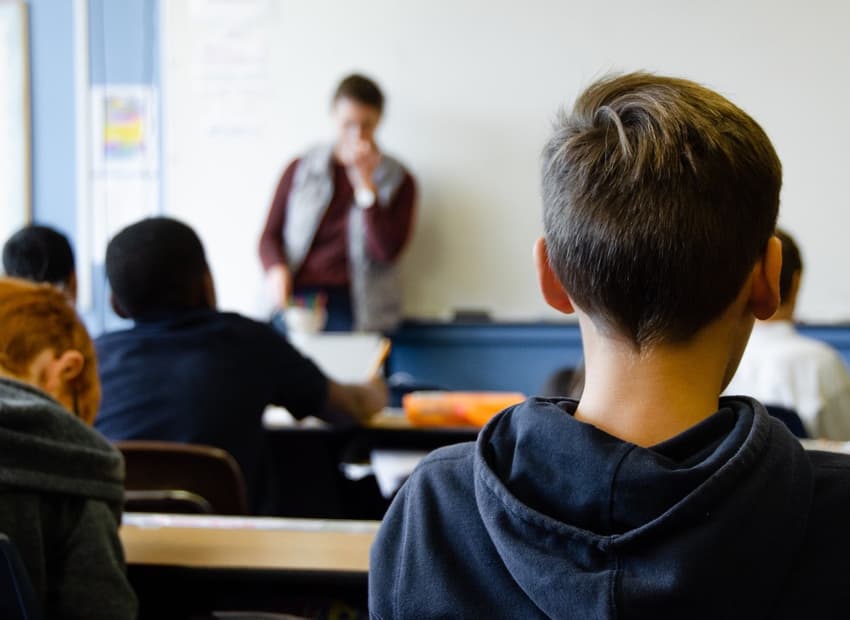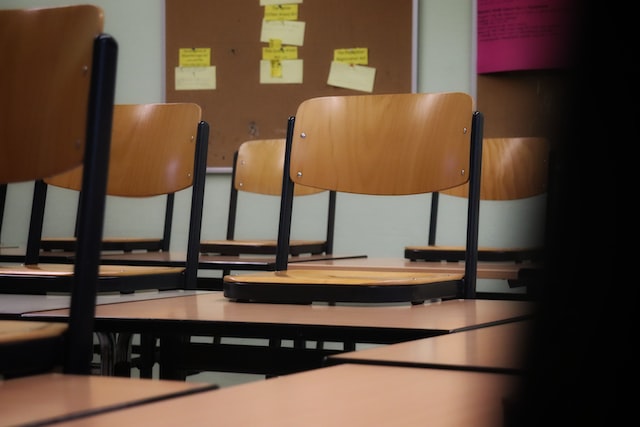5 things you never knew about Switzerland's school system

From different types of schools to competitive apprenticeships and lots of languages, here are 5 lesser-known facts about Switzerland’s education system that might surprise you.
A second local language is a must
Switzerland’s education system reflects the linguistic and cultural diversity that defines the country. Depending on the region, however, the language of instruction varies from German (not Swiss German!), French, Italian to Romansh. English - considered Switzerland unofficial fifth language – is taught in primary schools while an additional national language is gradually introduced throughout the pupils’ education. In some schools, students also have the option of choosing to learn a third national language.
While not the norm across Switzerland, some cantonal schools teach bilingual or immersive classes, meaning one or several subjects are taught in a foreign language (bilingual). If lessons are carried out entirely or mainly in a foreign language, this is usually referred to as immersive lessons.
In the German-speaking part of Bern, for instance, children are taught in German and French in some kindergartens and primary schools. The same is also the case for the French-speaking part of Fribourg as well as the cantons Neuchâtel and Valais.
In the canton of Graubünden pupils are either taught in a combination of Romansh and German, or Italian and German. Meanwhile, the canton of Solothurn teaches history and geography in French, while the canton of Schwyz educates pupils in both English and German – and that’s only to name a few!
READ ALSO: How much do international schools cost in Switzerland?
Education system by canton
For parents choosing which Swiss canton to move to, it may be beneficial to consider your local canton’s schooling system and how it differs from its surrounding cantons.

A pupil at school. Illustration photo by Tamarcus Brown on Unsplash
In Switzerland, the cantons are responsible for the compulsory schooling and they are obliged to harmonise important goals and structures nationwide. Hence, the mandatory attendance duration for the many school stages varies on a cantonal level.
Here's a look at mandatory primary school attendance: Ticino (5 years), Aargau, Appenzell Ausserrhoden, Appenzell Innerrhoden Basel Land, Basel Stadt, Bern, Glarus, Graubunden, Luzern, Nidwalden, Obwalden, Schaffhausen, Schwyz, Solothurn, St Gallen, Thurgau, Uri, Zug, Zurich (6 years), and Fribourg, Geneva, Jura, Neuchatel, Valais, Vaud ( 8 years).
Mandatory middle school attendance: Appenzell Ausserrhoden (2 years), Ticino (4 years), all other cantons (3 years).
Mandatory overall schooling period: Appenzell Ausserrhoden, Graubunden (9 years), Appenzell Innerrhoden, Lucerne, Nidwalden, Obwalden, Schwyz, Uri, Zug (10 years), and Aargau, Basel Land, Basel Stadt, Bern, Fribourg, Geneva, Glarus, Jura, Neuchatel, Schaffhausen, Solothurn, St. Gallen, Thurgau, Ticino, Valais, Vaud, Zurich (11 years).
Bez, Sek or Realschule
Once a student has successfully completed their stint in primary school, they are on to their next adventure: the Oberstufenschule. But while some pupils may very well look forward to being just that bit closer to teenagehood, they could be surprised to discover that they may not be joining their fellow classmates in that next chapter.
In Switzerland, the higher primary education is made up of three types of schools whose curricula are coordinated with one another: the Bezirksschule, Sekundarschule and Realschule. Where a pupil ends up depends on their learning speed, grades, and abstract thinking ability as each school teaches children according to their abilities.
In the Realschule, students acquire a broad general education and the basis needed for an apprenticeship. The graduates of the Realschule often move on to apprenticeships in a trade or in the industry.
READ ALSO: How Swiss teachers are taking on ChatGPT
Students of the Sekundarschule, which sits in the middle of the three schools, acquire a broad general education and the skills needed for a more demanding professional training. Though many Sekundarschule graduates go on to take up various apprenticeships, ranging from commercial diplomas to the field of IT, some with exceptional grades choose to attend specialised middle schools.
The Bezirkschule has the highest demands among the three and prepares its pupils for both vocational training as well as a range of for secondary schools. In view of their further education, the students therefore have to choose from a number of elective and optional subjects in addition to attending compulsory classes. A good half of the graduates start an apprenticeship in trades, industry and commerce, the rest attend a baccalaureate or technical school.
Side note: In some cantons, the names for the three schools can fall in a different order.

Chairs in a classroom. Photo by Jonas Augustin on Unsplash
Apprenticeships favoured over university
Given the fact that only the Bezirkschule enables students to move on to the gymnasium in preparation for university, it is not surprising that the majority of Swiss pupils opt for apprenticeships instead. Though this could also have to do with the fact that apprenticeships in Switzerland – which last three to four years on average - generally pay a decent wage, and what teenager doesn’t look forward to their very first pay!
In order to find an apprenticeship, however, students must carry out a range of preparatory tasks, such as completing professional and general aptitude tests, attending information events, job fairs, trial apprenticeships and of course put together their application.
In Switzerland, each Swiss canton has a list of employers with apprenticeship openings for the coming year as well as a booklet for primary school graduates to work through to figure out just what career suits their interests the best. But despite a shortage of skilled workers in multiple fields, finding an apprenticeship in Switzerland is no easy task.
Alternatives encouraged
Having decided on an apprenticeship over higher education, pupils might find themselves struggling to beat the competition. This year, 80 percent of apprenticeships – starting in the late summer 2023 – have already hired trainees.
However, there’s no reason for panic. Should a pupil be unable to secure a trainee job, not have sufficient grades, or simply be unsure about what career path to pursue, there are many interesting alternatives to consider. One of the most straightforward choices is deciding on a 10th school year (10. Schuljahr).
The 10th grade, also known as vocational school, allows students to slowly integrate into their desired professional life. Students who choose this path will benefit from a so-called preparation school, which will either focus on preparing them for vocational training or a secondary school, while also supporting them in their search for an apprenticeship should that be their choice.
Alternatively, pupils can opt for an internship or traineeship to get to know a professional field and make contact with potential employers.
Some also choose to use the extra year to hone their language skills with many graduates heading abroad to work as an au pair or as study a language in a school.
Comments
See Also
A second local language is a must
Switzerland’s education system reflects the linguistic and cultural diversity that defines the country. Depending on the region, however, the language of instruction varies from German (not Swiss German!), French, Italian to Romansh. English - considered Switzerland unofficial fifth language – is taught in primary schools while an additional national language is gradually introduced throughout the pupils’ education. In some schools, students also have the option of choosing to learn a third national language.
While not the norm across Switzerland, some cantonal schools teach bilingual or immersive classes, meaning one or several subjects are taught in a foreign language (bilingual). If lessons are carried out entirely or mainly in a foreign language, this is usually referred to as immersive lessons.
In the German-speaking part of Bern, for instance, children are taught in German and French in some kindergartens and primary schools. The same is also the case for the French-speaking part of Fribourg as well as the cantons Neuchâtel and Valais.
In the canton of Graubünden pupils are either taught in a combination of Romansh and German, or Italian and German. Meanwhile, the canton of Solothurn teaches history and geography in French, while the canton of Schwyz educates pupils in both English and German – and that’s only to name a few!
READ ALSO: How much do international schools cost in Switzerland?
Education system by canton
For parents choosing which Swiss canton to move to, it may be beneficial to consider your local canton’s schooling system and how it differs from its surrounding cantons.

In Switzerland, the cantons are responsible for the compulsory schooling and they are obliged to harmonise important goals and structures nationwide. Hence, the mandatory attendance duration for the many school stages varies on a cantonal level.
Here's a look at mandatory primary school attendance: Ticino (5 years), Aargau, Appenzell Ausserrhoden, Appenzell Innerrhoden Basel Land, Basel Stadt, Bern, Glarus, Graubunden, Luzern, Nidwalden, Obwalden, Schaffhausen, Schwyz, Solothurn, St Gallen, Thurgau, Uri, Zug, Zurich (6 years), and Fribourg, Geneva, Jura, Neuchatel, Valais, Vaud ( 8 years).
Mandatory middle school attendance: Appenzell Ausserrhoden (2 years), Ticino (4 years), all other cantons (3 years).
Mandatory overall schooling period: Appenzell Ausserrhoden, Graubunden (9 years), Appenzell Innerrhoden, Lucerne, Nidwalden, Obwalden, Schwyz, Uri, Zug (10 years), and Aargau, Basel Land, Basel Stadt, Bern, Fribourg, Geneva, Glarus, Jura, Neuchatel, Schaffhausen, Solothurn, St. Gallen, Thurgau, Ticino, Valais, Vaud, Zurich (11 years).
Bez, Sek or Realschule
Once a student has successfully completed their stint in primary school, they are on to their next adventure: the Oberstufenschule. But while some pupils may very well look forward to being just that bit closer to teenagehood, they could be surprised to discover that they may not be joining their fellow classmates in that next chapter.
In Switzerland, the higher primary education is made up of three types of schools whose curricula are coordinated with one another: the Bezirksschule, Sekundarschule and Realschule. Where a pupil ends up depends on their learning speed, grades, and abstract thinking ability as each school teaches children according to their abilities.
In the Realschule, students acquire a broad general education and the basis needed for an apprenticeship. The graduates of the Realschule often move on to apprenticeships in a trade or in the industry.
READ ALSO: How Swiss teachers are taking on ChatGPT
Students of the Sekundarschule, which sits in the middle of the three schools, acquire a broad general education and the skills needed for a more demanding professional training. Though many Sekundarschule graduates go on to take up various apprenticeships, ranging from commercial diplomas to the field of IT, some with exceptional grades choose to attend specialised middle schools.
The Bezirkschule has the highest demands among the three and prepares its pupils for both vocational training as well as a range of for secondary schools. In view of their further education, the students therefore have to choose from a number of elective and optional subjects in addition to attending compulsory classes. A good half of the graduates start an apprenticeship in trades, industry and commerce, the rest attend a baccalaureate or technical school.
Side note: In some cantons, the names for the three schools can fall in a different order.

Apprenticeships favoured over university
Given the fact that only the Bezirkschule enables students to move on to the gymnasium in preparation for university, it is not surprising that the majority of Swiss pupils opt for apprenticeships instead. Though this could also have to do with the fact that apprenticeships in Switzerland – which last three to four years on average - generally pay a decent wage, and what teenager doesn’t look forward to their very first pay!
In order to find an apprenticeship, however, students must carry out a range of preparatory tasks, such as completing professional and general aptitude tests, attending information events, job fairs, trial apprenticeships and of course put together their application.
In Switzerland, each Swiss canton has a list of employers with apprenticeship openings for the coming year as well as a booklet for primary school graduates to work through to figure out just what career suits their interests the best. But despite a shortage of skilled workers in multiple fields, finding an apprenticeship in Switzerland is no easy task.
Alternatives encouraged
Having decided on an apprenticeship over higher education, pupils might find themselves struggling to beat the competition. This year, 80 percent of apprenticeships – starting in the late summer 2023 – have already hired trainees.
However, there’s no reason for panic. Should a pupil be unable to secure a trainee job, not have sufficient grades, or simply be unsure about what career path to pursue, there are many interesting alternatives to consider. One of the most straightforward choices is deciding on a 10th school year (10. Schuljahr).
The 10th grade, also known as vocational school, allows students to slowly integrate into their desired professional life. Students who choose this path will benefit from a so-called preparation school, which will either focus on preparing them for vocational training or a secondary school, while also supporting them in their search for an apprenticeship should that be their choice.
Alternatively, pupils can opt for an internship or traineeship to get to know a professional field and make contact with potential employers.
Some also choose to use the extra year to hone their language skills with many graduates heading abroad to work as an au pair or as study a language in a school.
Join the conversation in our comments section below. Share your own views and experience and if you have a question or suggestion for our journalists then email us at [email protected].
Please keep comments civil, constructive and on topic – and make sure to read our terms of use before getting involved.
Please log in here to leave a comment.